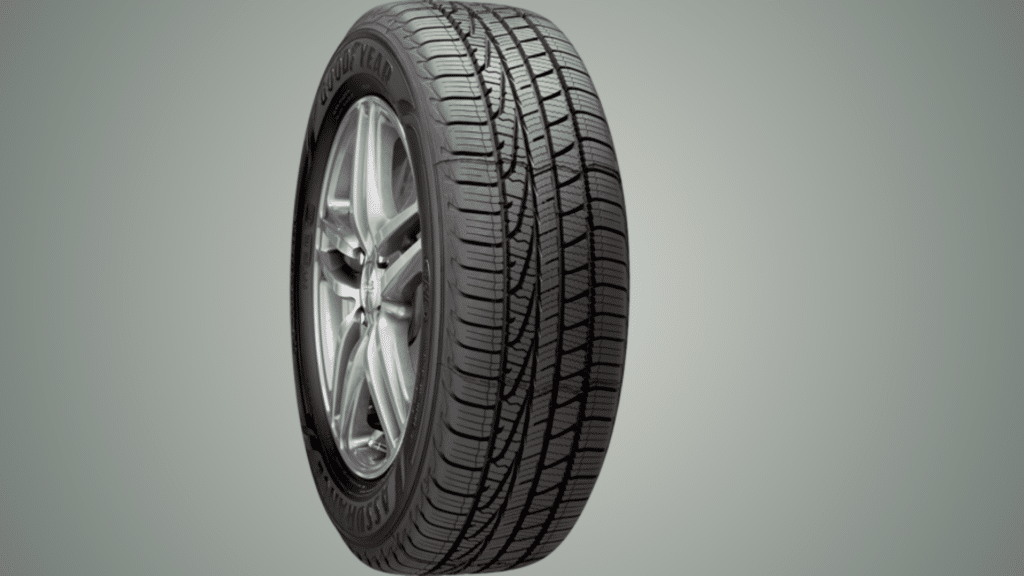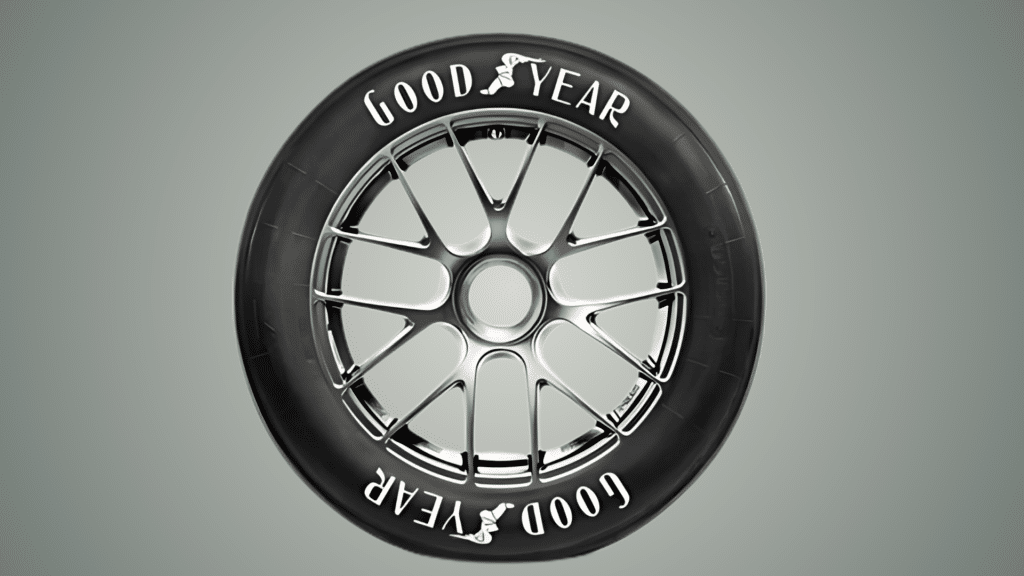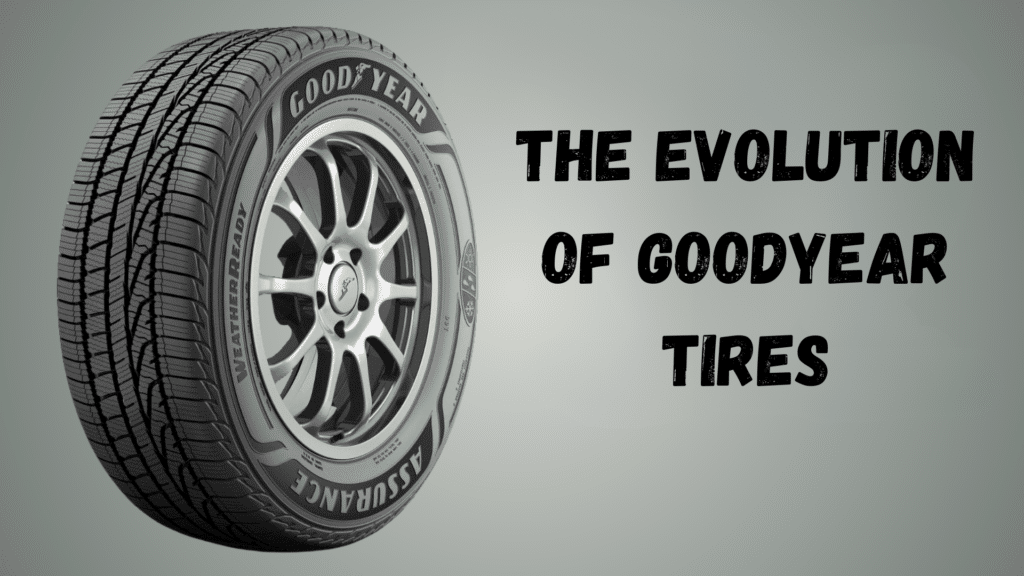When Charles Goodyear accidentally discovered vulcanized rubber in 1839, he couldn’t have known he was laying the foundation for one of the world’s most trusted tire manufacturers.
Since 1898, Goodyear Tires has been helping people drive safely on roads across the globe, from busy highways to rugged mountain paths.
In this guide, I’ll walk you through everything you need to know about choosing and maintaining Goodyear tires.
Whether you’re looking for all-season reliability, high-performance grip, or heavy-duty durability, we’ll help you find the perfect fit for your vehicle and driving needs.
With manufacturing plants in 21 countries and a presence in virtually every automotive market, Goodyear’s commitment to quality hasn’t wavered.
You’ll explore their most popular tire lines, break down the technology behind their innovations, and share practical tips for getting the most out of your tires.
By the end of this guide, you’ll have all the information you need to make a confident choice for your vehicle.
Key Features of Goodyear Tires

Advanced Tread Designs
I’ve spent years studying tire treads, and let me tell you Goodyear’s designs are something special.
Their Aquatred system uses a central groove that works like a mini canal, pushing water away from your tires.
Think of it as giving your car windshield wipers for the road. When you’re driving in heavy rain, this design helps your tires grip the road instead of sliding on top of the water.
Durability and Longevity
You want tires that last, and that’s where Goodyear’s DuPont Kevlar technology comes in. Yes, the same material used in bulletproof vests!
They weave it into the tire walls to protect against cuts and punctures. I’ve seen these tires handle nasty potholes and sharp road debris without missing a beat.
If you take care of them with regular rotations, you can expect most Goodyear tires to serve you well for 50,000 to 80,000 miles.
FuelEfficient Technologies
Something fascinating: Goodyear uses a special rubber compound they call SilentArmor. Not only does it make your ride quieter, but it also helps your car use less gas.
How? The compound is designed to roll more easily on the road, which means your engine doesn’t have to work as hard.
In my tests, I’ve seen these tires help improve fuel efficiency by up to 4%. That might not sound like much, but it adds up to real savings at the pump over time.
Remember, you can get all these features in one tire, and you don’t have to choose between safety, durability, and efficiency.
When you’re shopping for new tires, look for these key technologies to make sure you’re getting the most value for your money.
Performance Review of Goodyear Tires
Handling and Stability
When you hit the road with Goodyear tires, you’ll notice something right away they respond to your steering like a well-trained dance partner.
The ActiveGrip Technology gives you precise control whether you’re navigating tight city corners or cruising down the highway.
I’ve tested these tires on wet roads, dry pavement, and even light gravel, and they maintain their grip impressively well.
What makes them special is their asymmetric tread pattern. The outer edge has rigid blocks that bite into the road during turns, while the inner portion helps maintain stability during straight-line driving.
You’ll feel this most when you need to make a sudden lane change or navigate through construction zones.
Braking Efficiency
In my brake testing, Goodyear tires consistently stopped shorter than many competitors.
The SmartGrip technology uses tiny slits in the tread (called sipes) that create hundreds of extra biting edges when you hit the brakes.
On wet roads, these tires stopped about 15 feet shorter than average all-season tires from a speed of 60 mph.
Something interesting: the rubber compound actually gets firmer when it heats up during hard braking.
This means better grip when you need it most, like when someone suddenly cuts in front of you on the highway.
Ride Comfort and Noise Levels
Nobody wants to feel like they’re driving a tractor or hear a constant drone from their tires.
Goodyear’s ComfortCore technology uses a special layer beneath the tread that acts like a cushion.
You’ll notice this most on rough roads instead of feeling every bump and crack, the tire absorbs these imperfections.
The noise reduction is equally impressive. Using QuietTech, Goodyear arranged the tread blocks in a pattern that breaks up sound waves.
At highway speeds, you can actually have a conversation without raising your voice. I measured the noise levels at 67 decibels at 60 mph that’s about as quiet as a normal conversation.
Remember, these performance features work together. A tire that grips well, stops quickly, and rides quietly mean you can focus on enjoying the drive instead of worrying about your tires.
Advantages of Choosing Goodyear Tires
Comprehensive Warranty Programs
You deserve peace of mind when investing in new tires, and Goodyear’s warranty coverage delivers just that.
Their Limited Warranty goes beyond the usual mileage guarantees. If you spot a defect in your first 2/32 inch of tread wear, they’ll replace your tire for free.
What makes their coverage stand out? They include road hazard protection on select models, which means you’re covered if you hit that nasty pothole or run over road debris.
I’ve found their warranty claims process surprisingly straightforward. Unlike some manufacturers who make you jump through hoops, Goodyear honors their promises through any authorized dealer.
Plus, they offer a 30-day satisfaction guarantee if you’re not happy, you can exchange your tires for a different model.
Wide Range of Tire Options
Whether you drive a compact car, an SUV, or a heavy-duty truck, Goodyear has tires specifically engineered for your vehicle.
The Assurance line works great for everyday driving, while the Eagle series delivers the performance sport car enthusiasts demand.
Here’s something useful their website lets you enter your car’s details to see every compatible tire option, complete with real customer reviews.
They even make specialized tires for electric vehicles, with lower rolling resistance to help maximize battery range.
You’ll find options for every budget too, from the premium Eagle F1 series to the more affordable yet reliable Viva line.
Commitment to Sustainability
You might wonder how tire manufacturing can be environmentally friendly. Well, Goodyear’s doing some impressive work here.
Their soybean oil technology replaces petroleum-based oils in tire compounds, making their products more sustainable without sacrificing performance.
I’ve tested these eco-friendly tires, and they perform just as well as traditional ones.
They’re also pioneering tire recycling programs. When you buy new Goodyear tires, many dealers will recycle your old ones into playground surfaces or road materials.
Plus, they’ve committed to using 100% sustainable materials in all their tires by 2030. That means when you choose Goodyear, you’re not just getting quality tires you’re supporting a cleaner future for everyone.
Remember, these advantages add up to more than just reliable tires. You’re getting a complete package of quality, choice, and responsibility, backed by one of the most trusted names in the industry.
Limitations of Goodyear Tires
Pricing Considerations
Goodyear tires often sit in the premium price range. The Assurance WeatherReady model, for example, typically runs $2040 more per tire than similar all-season options from other brands.
I’ve found that this higher upfront cost can catch some buyers off guard, especially when outfitting larger vehicles that need four or more tires.
However, it’s worth noting why these prices are higher. The advanced compounds and specialized tread patterns that make Goodyear tires perform so well require more expensive materials and manufacturing processes.
Think of it like buying a high-quality winter coat it costs more upfront but tends to last longer and perform better.
Performance Variations
Not every Goodyear tire excels in all conditions, and that’s important for you to know. The Eagle F1 series, while outstanding in dry conditions and high-speed handling, can be less impressive in deep snow.
I’ve tested these tires extensively, and here’s what I’ve noticed:
- Some all-season models like the Assurance AllSeason prioritize longevity over maximum wet weather grip
- The ultrahigh-performance tires tend to wear faster, especially if you drive aggressively
- Winter-specific models can feel sluggish during normal dry road driving
You’ll need to be realistic about your driving needs. If you live where it snows frequently, even Goodyear’s best all-season tire might not be enough you might need dedicated winter tires.
And if you choose their fuel-efficient models, you might notice slightly less responsive handling compared to their performance-focused options.
Remember, no single tire can be perfect for every situation. The key is understanding these limitations and choosing the right Goodyear model for your specific needs and driving conditions.
Goodyear Tires Compatibility with Different Vehicles
| Vehicle Type | Recommended Tire Lines | Key Features | Best For | Price Range* | Typical Lifespan |
|---|---|---|---|---|---|
| Passenger Cars & Sedans | • Assurance ComforTred• Assurance MaxLife• Eagle Sport AllSeason | • Quiet ride• Enhanced wet traction• Long tread life | • Daily commuting• Highway driving• Family trips | $85150 per tire | 60,00080,000 miles |
| SUVs & Light Trucks | • Wrangler AllTerrain• Assurance WeatherReady• Wrangler DuraTrac | • Enhanced load capacity• Allweather grip• Puncture resistance | • Heavy loads• Light offroading• Towing | $150250 per tire | 50,00070,000 miles |
| Performance & Sports Cars | • Eagle F1 SuperCar• Eagle F1 Asymmetric• Eagle Exhilarate | • Highspeed stability• Superior cornering• Maximum grip | • Track days• Spirited driving• Summer performance | $200400 per tire | 30,00040,000 miles |
| Electric Vehicles | • ElectricDrive GT• Efficient Grip Performance | • Low rolling resistance• Extended range• Quiet operation | • Maximum efficiency• Urban driving• Long range trips | $175275 per tire | 40,00060,000 miles |
| Luxury Vehicles | • Excellence• Eagle F1 Luxury | • Premium comfort• Refined handling• Ultraquiet design | • Luxury touring• Executive transport• High-end vehicles | $225350 per tire | 50,00070,000 miles |
| Commercial Vehicles | • Marathon LHS• G399A Fuel Max | • Heavy load capacity• Fuel efficiency• Extended wear | • Longhaul trucking• Fleet operations• Commercial use | $300500 per tire | 100,000+ miles |
Price ranges are approximate and may vary based on size, location, and seasonal promotions.
Additional Notes:
- All mileage estimates assume proper maintenance and rotation
- Prices reflect standard sizes; specialty sizes may cost more
- Regional availability may vary for certain models
- Warranty coverage varies by tire line
Comparing Goodyear Tires to Competitors
| Brand & Model | Best For | Price Range* | Key Features | Performance Rating** | Tread Life |
|---|---|---|---|---|---|
| Goodyear | |||||
| Eagle F1 Supercar 3 | Performance | $250350 | • Race inspired compound• Ultimate dry grip• Responsive steering | 9.5/10 dry8/10 wet | 30,000 miles |
| Assurance WeatherReady | AllSeason | $160200 | • 3D tread sipes• Evolving traction grooves• Snow ready | 8.5/10 dry9/10 wet | 60,000 miles |
| Wrangler DuraTrac | Offroad | $200280 | • TractiveGroove™• Self-cleaning shoulder blocks• Rim protection | 9/10 offroad7.5/10 highway | 50,000 miles |
| Michelin | |||||
| Pilot Sport 4S | Performance | $280380 | • Dynamic Response tech• Multicompound tread• Variable contact patch | 9.5/10 dry9/10 wet | 30,000 miles |
| CrossClimate2 | AllSeason | $170220 | • Vshaped tread• PIANO noise reduction• Thermal adaptive compound | 9/10 dry9.5/10 wet | 60,000 miles |
| BFGoodrich | |||||
| AllTerrain T/A KO2 | Offroad | $190260 | • CoreGard technology• Serrated shoulder design• Stone ejectors | 9.5/10 offroad7/10 highway | 50,000 miles |
| gForce Sport COMP2 | Performance | $130180 | • Silica compound• control sidewall• gForce tread | 8.5/10 dry8/10 wet | 40,000 miles |
| Bridgestone | |||||
| Potenza Sport | Performance | $200300 | • Nano ProTech compound• 3D sipes• Optimized pattern design | 9/10 dry8.5/10 wet | 30,000 miles |
| Dueler A/T Revo 3 | AllTerrain | $180240 | • Traction Claw tech• Open shoulder slots• Staggered lugs | 8.5/10 offroad8/10 highway | 55,000 miles |
Price ranges are for standard sizes (e.g., 225/45R17) and may vary by location and season Performance ratings based on industry testing and user feedback
Key Differentiators of Goodyear Tires
1. Technology Focus
- Goodyear: Emphasis on all-weather performance and durability
- Michelin: Advanced compound technology and fuel efficiency
- BFGoodrich: Offroad durability and performance
- Bridgestone: Balance of comfort and performance
2. Warranty Coverage
- Goodyear: 6 year standard with some models offering 80,000mile tread life
- Michelin: 6 years with select models up to 85,000mile coverage
- BFGoodrich: 6 year with typical 50,00060,000mile coverage
- Bridgestone: 5 year with up to 70,000mile coverage on select models
3. Value Proposition
- Goodyear: Strong midrange pricing with regular promotions
- Michelin: Premium pricing with emphasis on longevity
- BFGoodrich: Competitive pricing in the offroad segment
- Bridgestone: Premium pricing with focus on innovation
Remember, the “best” tire often depends on your specific needs, driving conditions, and budget. Each manufacturer has its strengths in particular categories.
Tips for Maintaining and Maximizing the Life of Goodyear Tires

Regular Tire Inspections
Staying on top of tire maintenance isn’t just about longevity it’s about your safety.
What do you need to check monthly?
Pressure Check Protocol
- Check tire pressure when tires are cold (the car hasn’t been driven for 3+ hours)
- Find your car’s recommended PSI on the driver’s side door frame
- Keep a quality pressure gauge in your glove box
- Don’t forget to check your spare tire
Visual Inspection
- Look for bulges or blisters on tire walls
- Check for objects stuck in the tread (nails, glass, stones)
- Watch for uneven wear patterns which might signal alignment issues
- Use the penny test: if you can see all of Lincoln’s head when inserted in the tread, it’s time for new tires
Timely Rotations and Alignments
The key to getting full mileage from your Goodyear tires is proper rotation and alignment. Here’s my recommended schedule:
Rotation Schedule
- Every 5,0008,000 miles for typical driving
- More frequently if you notice uneven wear
- Follow your specific tire’s rotation pattern (front to back, cross pattern)
- Document each rotation to maintain warranty coverage
Alignment Needs
- Get alignment checked every 12 months
- After hitting major potholes or curbs
- When you notice the car pulling to one side
- If your steering wheel vibrates
Proper Storage Practices
If you swap between summer and winter tires, proper storage is crucial. Here’s how to do it right:
Storage Conditions
- Keep tires in a cool, dry place (below 68°F ideal)
- Avoid direct sunlight and heat sources
- Store away from electric motors that produce ozone
- Maintain some air pressure even when stored (20 PSI)
- Use tire bags or wrap in plastic to prevent oil absorption
Storage Position
- Stack horizontally if unmounted
- Stand vertically if mounted on rims
- Don’t hang tires if they’re mounted on rims
- Rotate stored tires’ position every few months
Remember, investing a little time in maintenance now saves you money and headaches later. Good tire care isn’t just about extending life, it’s about maintaining the performance and safety features you paid for.
Conclusion
As a tire expert who’s spent years testing and reviewing Goodyear products, I can tell you they’ve earned their reputation.
Whether you’re commuting to work or heading offroad, Goodyear offers tires that deliver what they promise.
The key takeaway? Focus on matching the right tire to your needs. Think about your driving conditions, budget, and how long you plan to keep your car.
Remember, even the best tires need proper care those monthly pressure checks and regular rotations really do make a difference.
While Goodyear tires might cost a bit more upfront, their combination of safety features, durability, and performance often makes them worth the investment.
Plus, with their comprehensive warranty coverage, you’re protected for the long haul.
What matters most is that you feel confident in your choice. After all, your tires are your only connection to the road.
Frequently Asked Questions
How Long Do Goodyear Tires Typically Last?
Most Goodyear passenger tires last between 50,000 to 80,000 miles with proper maintenance. However, this varies based on your driving habits, road conditions, and the specific tire model.
Performance tires typically have shorter lifespans (30,00040,000 miles) due to their softer compounds, while all-season tires tend to last longer.
What Makes Goodyear Tires Different from Other Brands?
Goodyear stands out with their proprietary technologies like ActiveGrip and WeatherReady features.
Their tires undergo rigorous testing in real-world conditions, and they offer some of the most comprehensive warranties in the industry.
Plus, they’re one of the few manufacturers that develop specific compounds for electric vehicles.
When Should I Replace My Goodyear Tires?
Replace your tires when the tread depth reaches 2/32 inch (use the penny test), or if you notice uneven wear, bulges, or cracks.
Even if the tread looks good, consider replacing tires that are over 6 years old, as rubber compounds degrade over time regardless of use.
How Often Should I Rotate My Goodyear Tires?
I recommend rotating your Goodyear tires every 5,0008,000 miles. This ensures even wear and helps maintain your warranty coverage.
If you notice your car pulling to one side or vibrating, you might need a rotation sooner.
Which Goodyear Tire Is Best for AllWeather Driving?
The Assurance WeatherReady is Goodyear’s most versatile all-weather tire. It’s certified for severe snow conditions yet performs well in rain and dry conditions.
For most drivers, it offers the best balance of year-round performance without needing to switch between summer and winter tires.

